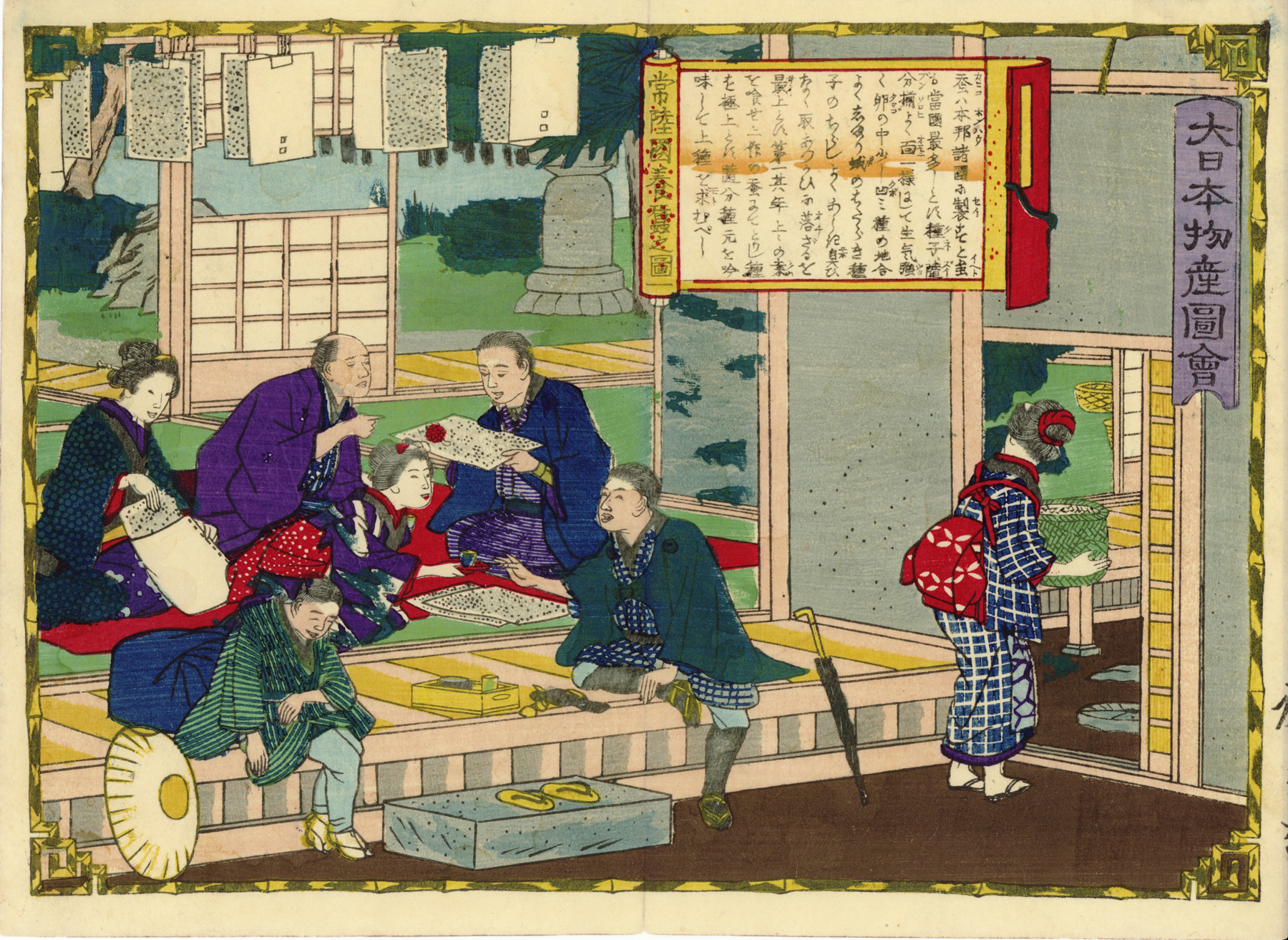About This Print
One of 118 prints in the series Dai Nippon Bussan Zue (Products of Greater Japan), issued in August 1877 to coincide with the opening of Japan’s first National Industrial Exposition (Naikoku Kangyō Hakurankai) held in Tokyo’s Ueno Park. It depicts silk industry merchants in Hitachi 常陸 province examining sheets of papers on which silk moths laid their eggs. Hitachi Province (常陸国, Hitachi no Kuni) was an old province of Japan in the area of Ibaraki Prefecture. Hitachi Province bordered on Iwashiro, Iwaki, Shimousa, and Shimotsuke Provinces.Hitachi province was a mostly agricultural area. It "gradually became a more important production region for cocoons and raw silk, and by the early 1890s the value of the cocoons its residents produced surpassed that of raw cotton."1
In keeping with the importance of sericulture to Japan's economy and industrialization, seven prints in the series are devoted to it. The Exposition was essentially "an industrial promotion opportunity providing a meeting place for Western technologies and their Japanese counterparts."2 "Silk production was the first example of an industry in which European producers deliberately sought out Japanese know-how" and "the source of Japan's first export technology."3
1 Japan's Protoindustrial Elite: The Economic Foundations of the Gōnō, Edward E. Pratt, Harvard University Asia Center, 1999, p. 117.
The six prints in the series depicting silkworm culture are:
Silkworm Culture in Hida Province (figure 2) 飛騨国 養蚕之図 二
Silkworm Culture in Shimotsuke Province (figure 3) 下野国 養蠶國 三
Silkworm Culture in Rikuzen Province (figure 5) 陸前国 養蠶図 五
Silkworm Culture in Rikuchū Province (figure 6) 陸中国 養蚕之図 六
Transcription of Scroll
Source: with thanks to Yajifun http://yajifun.tumblr.com/Silkworm Culture in Hitachi Province #1 常陸國養蠶之圖 一
“蚕ハ本邦諸國に製すと?(雖)も當國最多しとす 種子隨分揃よく面一様にして生気強く卵の中少し凹ミ種の地合よくしなり蛾のはたらき種子のちらしよくあしき臭ひなく取りあつかひに落ざるを最上とす 第一其年上々の?(クハ)を喰せ上作の蚕にてとりし種を極上とす 随分種元を吟味して上種を求むべし” ※クハ 桑
Multiple Editions (Variant Printings)
At least three variant printings (editions) were made of this series. Each variant printing uses a different colored cartouche containing the series' title, either red, green or rainbow-colored. Different colored borders were also used and variances in the use of colors and shading are present in the three editions.
2 Website National Diet Library https://www.ndl.go.jp/exposition/e/s1/naikoku1.html
3 "Sericulture and the Origins of Japanese Industrialization", Tessa Morris-Suzuki, appearing JSTOR, Vol. 33, No.1, January 1992, p. 1-2-103; p. 121.
PowerPoint Presentation Notes from 1-31-2017 Presentation
Shipping Ice from Hakodate, Hokkaidō, Coal Mining in Iga Province and Silkworm Culture in Hitachi Province from the series Products of Greater Japan, 1877
This series of 118 prints depicts various economic activities throughout Japan. Its release coincided with the opening of Japan’s First National Industrial Exposition held in Tokyo’s Ueno Park in August 1877. The show’s exhibits, collected from across Japan, were categorized into six groups - mining and metallurgy, manufactures, fine art, machinery, agriculture, and horticulture. Nearly half a million visitors attended during its 3 month run and four more exhibitions were to follow. These fairs were modeled after Western industrial exhibitions and provided “a meeting place for Western technologies and their Japanese counterparts.”
National Diet Library website http://www.ndl.go.jp/exposition/e/s1/naikoku1.html
These three prints are from a series of 118 prints depicting various economic activities throughout Japan. The prints were big sellers both during and after the First National Industrial Exposition held in Tokyo’s Ueno Park in August 1877, while the Satsuma Rebellion raged 600 miles southwest of the capital. The prints were sold individually and also bound into books for sale. Nearly half a million visitors attended the exposition during its three month run and four more exhibitions were to follow.
PowerPoint Presentation Notes from 1-31-2017 Presentation
| Shipping Ice from Hakodate, Hokkaidō, Coal Mining in Iga Province and Silkworm Culture in Hitachi Province from the series Products of Greater Japan, 1877 This series of 118 prints depicts various economic activities throughout Japan. Its release coincided with the opening of Japan’s First National Industrial Exposition held in Tokyo’s Ueno Park in August 1877. The show’s exhibits, collected from across Japan, were categorized into six groups - mining and metallurgy, manufactures, fine art, machinery, agriculture, and horticulture. Nearly half a million visitors attended during its 3 month run and four more exhibitions were to follow. These fairs were modeled after Western industrial exhibitions and provided “a meeting place for Western technologies and their Japanese counterparts.” National Diet Library website http://www.ndl.go.jp/exposition/e/s1/naikoku1.html These three prints are from a series of 118 prints depicting various economic activities throughout Japan. The prints were big sellers both during and after the First National Industrial Exposition held in Tokyo’s Ueno Park in August 1877, while the Satsuma Rebellion raged 600 miles southwest of the capital. The prints were sold individually and also bound into books for sale. Nearly half a million visitors attended the exposition during its three month run and four more exhibitions were to follow. |
Print Details
latest revision:
| IHL Catalog | #589 |
| Title or Description | Picture of Silkworm Culture (Sericulture) in Hitachi (Ibaraki) Province (figure 1) 常陸国養蚕之図一 |
| Series | Dai Nippon Bussan Zue 大日本物産図会 (Products of Greater Japan) |
| Artist | Utagawa Hiroshige III (1842–1894) |
| Signature | 廣重筆 Hiroshige hitsu in bottom right margin (trimmed on this print) |
| Seal | none |
| Publication Date | 1877 (Meiji 10) |
| Publisher | Ōkura Magobei 大倉孫兵衛 (Kin'eido; 1843-1921) [Marks: pub. ref. 627] |
| Impression | excellent |
| Colors | excellent |
| Condition | good - vertical center fold |
| Genre | nishiki-e; kaika-e |
| Miscellaneous | |
| Format | chuban |
| H x W Paper | 6 7/8 x 9 3/8 in. (17.3 x 23.8 cm) |
| H x W Image | 6 3/8 x 9 in. (16.2 x 22.9 cm) |
| Literature | |
| Collections This Print | Art Gallery of Greater Victoria 2009.026.003 |
3/26/2020

![Manufacturing Imari Porcelain in Hizen [Province], figure 1 from the series Dai Nippon Bussan Zue (Products of Greater Japan)](../hideo-hagiwara-1913---2007-/germination-2/Next-print-rev1-30x30.jpg)
